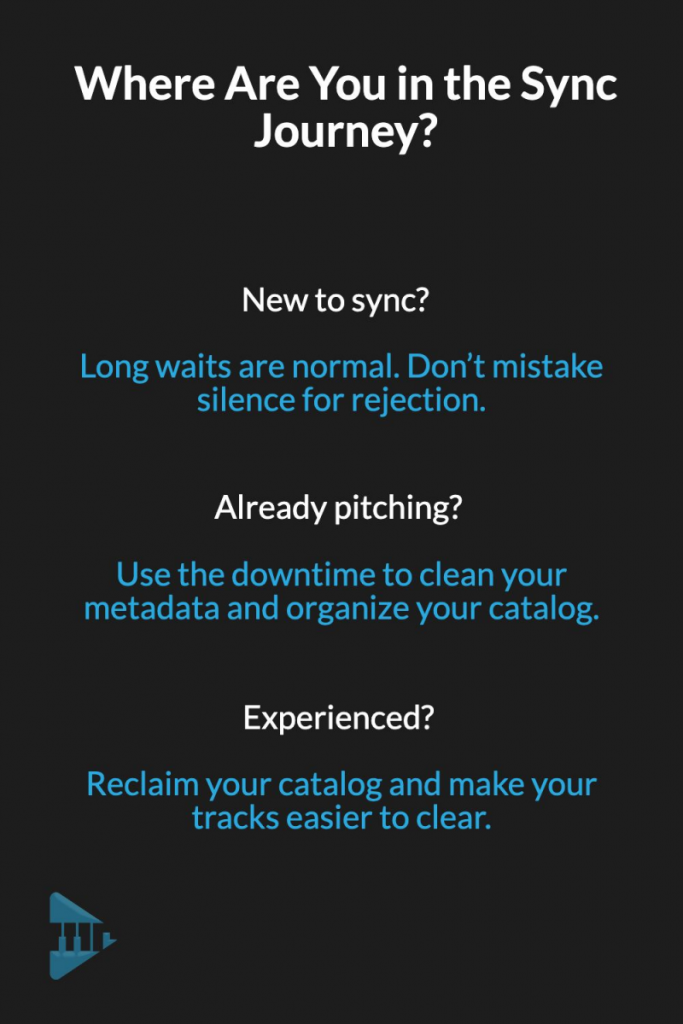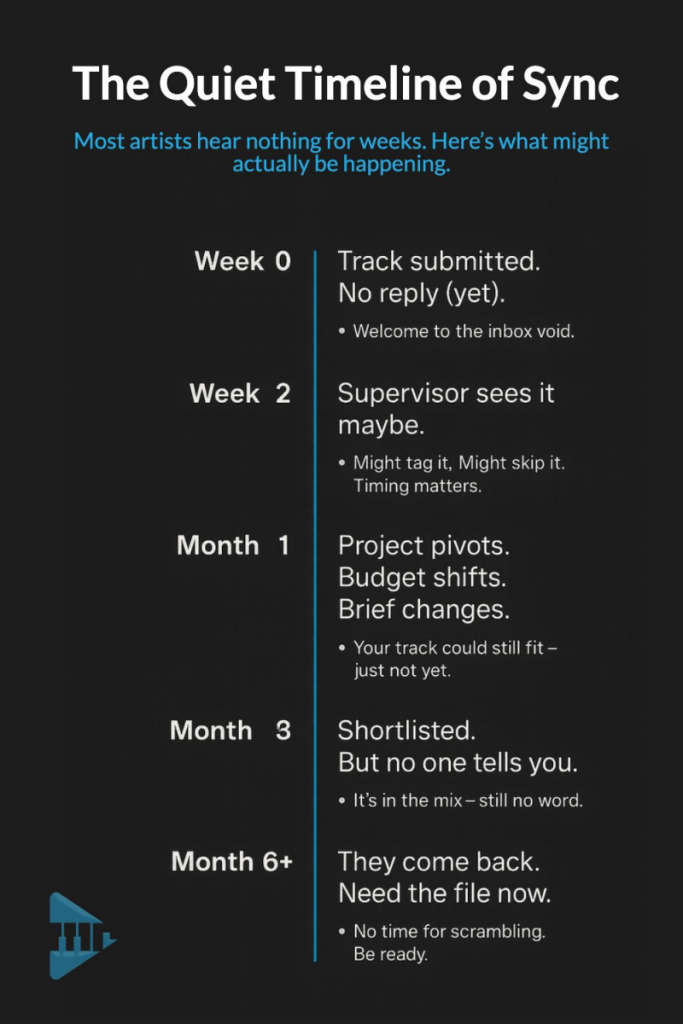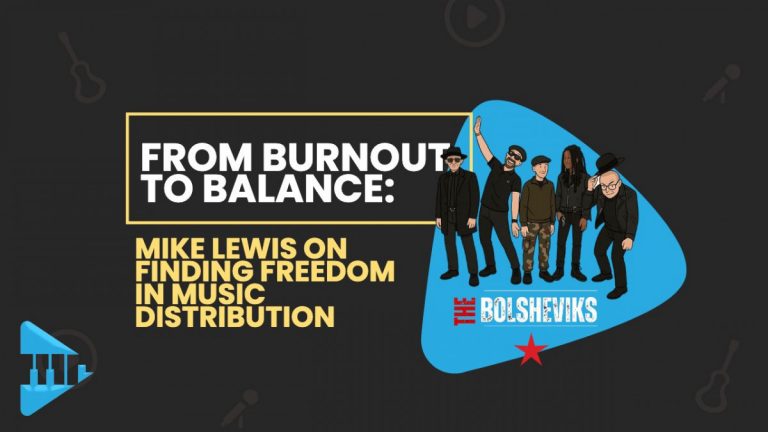Table of Contents
Toggle(TL;DR) Quick Answer: How to Get A Sync License. What Happens After You Submit?
Submitting your music for sync often means silence, that doesn’t mean rejection. Placements can take months, even a year, to land. The best move is to keep pitching, keep a clear record of where you’ve pitched, and stay sync-ready so you can respond fast when something finally moves.
You Sent Your Track for Sync Licensing. Now What?
You’ve done the work. The track is tagged, rights sorted, everything submitted, now comes the wait.
Days pass, then weeks. Silence. What felt like progress starts to feel like doubt.
Did they hear it? Was it the right fit? Should you follow up or let it go?
This is the moment that breaks many artists. Not because the music isn’t ready, but because silence feels like rejection.
But here’s the truth: silence is part of the process. And instead of sitting still, there are things you can do to stay ready and keep moving forward.
That silence feels different depending on where you are in your sync journey.
Where Are You in the Sync Journey?
- New to sync? Long waits are normal, don’t mistake silence for rejection.
- Already pitching? Use the downtime to clean your metadata and organize your catalog.
- Experienced? Reclaim your catalog and make your tracks easier to clear.

Where This Guide Fits In
This is Part 3 of our sync licensing series.
Part 1: What Is a Synchronization License
(covers the basics: what sync is, what rights are involved, why it matters)
Part 2: How to Submit Music for Film and TV
(covers the pitching process: how to prepare files, where to submit, who to contact)
Part 3 (You’re Here): How to Get Sync Placements (Even When No One Emails Back)
(covers the waiting stage: what silence means, what to do, how to stay ready)
Why Hearing Nothing After a Sync Submission Isn’t Always Song Rejection
Take Lena, an independent producer. She sent three tracks to sync licensing companies and heard nothing for weeks. Her first thought? “Maybe my music isn’t good enough.”
In reality, her songs weren’t rejected. They were sitting in inboxes, waiting for the right project. Three months later, one landed in a streaming series.
The reason it worked out: Lena tracked everything. She knew what she sent, when, and where. When the call came, she responded fast and professionally.
That’s how sync often plays out. As one artist put it on Reddit: “95% of libraries never reply, and placements can take nine months to come through.”
Source: Reddit
Lena’s win shows it’s possible, but it also highlights how rare placements are and why the odds feel so stacked.

Why Sync Placements Are So Hard to Land
Getting a sync placement isn’t about how good your music is. It’s about beating the odds. One breakdown puts it at just one placement for every 300 tracks submitted – about a 0.3% success rate.
So why is it so tough?
Because sync is full of bottlenecks and gatekeepers.
The Main Sync Gatekeepers
Music Supervisors
They make the final calls on what gets placed in film, TV, ads, and games. Speed and clearance are everything, which is why they lean on trusted sources.
Sync Agents
Agents pitch directly to supervisors. They only send music they believe fits, which makes them selective but powerful allies.
Music Libraries
Libraries are massive and often overcrowded. Unless your track is curated or tagged well, it can get buried.
Publishers
If you’re signed, they may control when and how your tracks are pitched. Some push sync hard, others barely touch it.
Metadata and File Prep
Even great music gets skipped if it’s missing stems, alt versions, or clear ownership. Supervisors need tracks that are instantly usable.
Ad Agencies and Production Teams
Sometimes they license music directly. But most stick to catalogs and artists they already know.
The bottom line: The silence you hear isn’t about talent. It’s about access, preparation, and timing.
Big-picture odds are one thing. But on the ground, silence usually comes down to practical roadblocks.
Why Silence Happens
Even if your track is strong, these roadblocks can slow or block a placement:
- The project changed direction
- The supervisor’s inbox was full
- Your track was saved for later but not chosen
- Rights clearance got stuck
- Budgets were shifted or cut
- The file format was wrong or stems were missing
It’s not about talent. It’s about timing, preparation, and access.
You can’t control those roadblocks. What you can control is how you use the waiting time.

Sync isn’t about instant wins. It’s about staying ready while the world catches up to your music.
What to Do After You Submit Music for Sync Licensing
What to Do After You Submit Music for Sync Licensing
Just because it’s quiet doesn’t mean you’re stuck. Use the time to get your catalog in shape so you’re ready when something moves.
Audit Your Rights and Metadata
Make sure your tracks are properly registered with your PRO and your ISRCs are in place. Without registration, a track can’t earn even if it gets placed. A track can’t earn if it’s not properly registered.
Learn the basics of sync rights in Part 1
Keep Pitching
One pitch rarely lands the deal. Keep sending your music to new libraries, agencies, and supervisors. Momentum builds through volume.
Check Part 2 for how to pitch your music for film and TV
Why Melody Rights Was Built in the First Place
Bobby Cole didn’t set out to build a platform. He was just trying to get his own music placed.
For years, he pitched tracks to libraries and sync contacts, juggling metadata, files, and emails across dozens of projects. When something finally landed, he couldn’t always remember what version he sent or where it went.
That chaos is what sparked Melody Rights.
He built the system he needed as an artist. One that organizes your catalog, protects rights, and keeps everything ready in one place, not just for him, but for every independent musician facing the same mess.
Melody Rights wasn’t built to take over. It was built to have your back.
How Melody Rights Helps You Break Through
Getting your music placed isn’t just about making great tracks. It’s about access, preparation, and timing. That’s where Melody Rights comes in.
We Work with Sync Agents and Supervisors
Your music doesn’t sit in a random queue. Melody Rights delivers it to working sync agents and supervisors already placing tracks in film, TV, ads, and games.
Your Track Joins a Curated Catalog
Every song is tagged and organized by genre, mood, and licensing terms. That makes it easier for gatekeepers to find and clear your track. The more artists contribute, the stronger and more valuable the catalog becomes.
You Stay Independent
You can still pitch on your own, but with Melody Rights your catalog is backed by a system that protects your rights, organizes your catalog, and keeps everything placement-ready.
Melody Rights vs Traditional Distribution
Most distributors are designed for streaming, not sync. That’s why so many artists end up frustrated. Your music gets uploaded, but it isn’t prepared or delivered for licensing opportunities.
Here’s how Melody Rights compares:
| Feature | Traditional Music Distribution | Melody Rights (Sync Licensing Focused) |
| Catalog Delivery | Focused on streaming platforms, no sync delivery | Entire catalog blanket-sent to active sync agents & supervisors |
| Rights & Metadata | Left to the artist to manage | ISRCs, PROs, cue sheets, and metadata organized for sync use |
| Catalog Protection | Only protected if placed | Rights secured and catalog prepped from day one |
Traditional distributors are built to get your music onto streaming platforms. Melody Rights is built to get your music into sync licensing opportunities. With rights management, catalog protection, and sync-focused preparation, your songs are always placement-ready.
Sync Licensing Success Isn’t About Hustle
Sync placements don’t always go to the loudest or even the most talented. They go to the artists who are ready when the call comes.
If your catalog is organized, your rights are clear, and your files are placement-ready, you give yourself the best chance to land the deal when the timing lines up.
Tired of Sync Silence?
Stop sending music into the void. Melody Rights helps you protect your catalog, and stay ready for placements, without the chaos of emails and spreadsheets.
Get started with Melody Rights today
FAQs About Sync Submissions and Silence
How long does sync licensing take?
Placements rarely happen fast. A track can sit for months before being placed, and sometimes more than a year.
Does silence mean my music was rejected?
Not always. Most sync companies only reach out if they’re moving forward. Silence often means your track is still sitting in a folder.
Can I follow up with sync licensing companies?
A polite follow-up is fine, but most supervisors prefer you don’t chase. A better move is to keep pitching while keeping your catalog organized.
How can I track where I’ve sent my music?
Spreadsheets and notes work, but tools like Melody Rights make it easier by keeping your rights data in one place.
What makes a track more syncable?
Songs that are easy to license stand out: clean metadata, alt versions, stems, and clear rights ownership. Supervisors look for tracks they can clear quickly without legal issues.
Does Melody Rights track every submission?
No. Melody Rights does not log each individual pitch or send updates if a track is shortlisted. Instead, we take a different approach. Your full catalog is delivered to trusted sync agents and supervisors. If a placement lands and the licensing payment clears, you get paid. Our focus is on keeping your catalog organized, rights-secure, and always sync-ready so you do not miss opportunities when they come.



